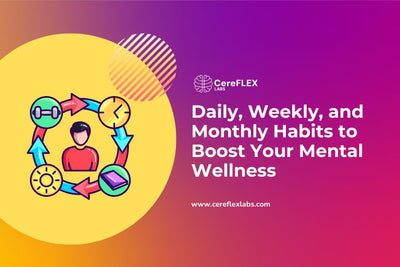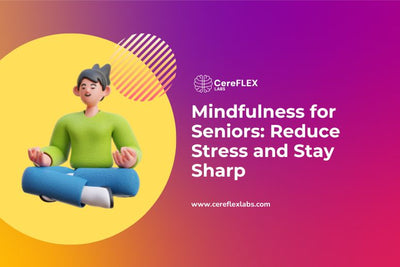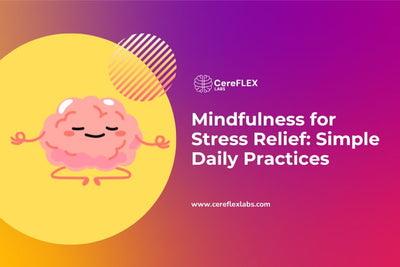Growing older brings gifts like wisdom, perspective, and the freedom to focus on what matters most. It can also bring challenges: changes in memory and mobility, feelings of stress, loneliness, or uncertainty.
Mindfulness offers a simple, gentle way to navigate these changes. By being fully present in the moment, seniors can boost focus, reduce stress, lift mood, and support brain health.
This doesn’t require hours of meditation or complex routines. A few mindful breaths in the morning, a slow walk in nature, or truly listening to a favourite song can bring meaningful shifts. Mindfulness can be woven into daily life, regardless of mobility or experience.
At CereFLEX Labs, we believe cognitive wellness is a lifelong journey. Combining mindfulness with proactive brain health support can help seniors stay mentally sharp, emotionally balanced, and physically at ease — one mindful moment at a time.
Here is the Quick Answer |
|
Mindfulness can help seniors ease stress, sharpen focus, lift mood, and support brain health. Simple daily practices — such as breathing exercises, journaling, walking meditation, chair yoga, and connecting with nature — can be adapted to any lifestyle or mobility level. Starting small, practicing consistently, and pairing mindfulness with healthy daily habits makes it easier to sustain. For added support, the CereFLEX Labs AM/PM Protocol provides vitamins, minerals, and antioxidants to help maintain mental clarity and overall well-being. |
The Benefits of Mindfulness for Seniors
Mindfulness isn’t just a wellness buzzword. It’s a well-researched practice with measurable benefits for brain health, emotional stability, and overall well-being, especially in later life.
By focusing on the present moment with curiosity and without judgment, seniors can strengthen mental sharpness, improve mood, and support physical health in ways that are gentle yet deeply effective.

Memory Retention and Working Memory
Regular mindfulness, including meditation, can strengthen short-term recall and help preserve long-term memory. Studies suggest it may even slow cognitive decline, including conditions like Alzheimer’s disease and dementia.
Sharper Focus and Attention
Mindfulness improves attention span, alertness, and decision-making. This can make it easier to enjoy hobbies, follow conversations, or focus on daily activities without distraction.
Neuroplasticity and Brain Health
Research shows mindfulness can increase grey matter in brain regions linked to learning and memory. These structural changes support adaptability, problem-solving skills, and resilience against age-related decline.
Reduced Anxiety and Stress Relief
Life changes such as retirement, health concerns, or moving to a new environment can trigger stress. Mindfulness techniques like deep breathing and guided meditation activate the body’s relaxation response, lowering heart rate, easing muscle tension, and calming the mind.
Improved Mood and Emotional Regulation
By training attention on the present instead of past regrets or future worries, mindfulness helps reduce symptoms of depression and promotes balanced emotions.
Greater Sense of Purpose
Mindfulness can reconnect seniors with relationships, passions, and simple daily joys. Paired with healthy lifestyle habits, it can inspire a renewed sense of meaning.
Lower Blood Pressure and Heart Health
The stress-reducing effects of mindfulness can help maintain healthy blood pressure levels, supporting cardiovascular health.
Better Sleep Quality

Practising mindfulness before bed can quiet a racing mind, making it easier to fall asleep and stay asleep.
Pain Management
Gentle mindfulness exercises can shift attention away from chronic pain, making it less overwhelming and more manageable.
Even a few mindful minutes each day can create a ripple effect, strengthening the mind, soothing the heart, and supporting the body for a calmer, healthier chapter of life.
Common Challenges Seniors Face in Practicing Mindfulness
Mindfulness can be life-changing, but it’s not without challenges, especially for older adults who may face unique physical, sensory, or cognitive barriers. The good news? Most can be overcome with small, thoughtful adaptations.
Mobility Limitations
Images of mindfulness often show people cross-legged on the floor or in advanced yoga poses. For seniors with arthritis, joint pain, or balance issues, these positions may be uncomfortable or unsafe.
Adaptation: Mindfulness doesn’t require complex postures. Chair yoga, seated meditation, or mindful breathing while lying down can be just as effective.
Sensory Impairments (Vision or Hearing Loss)
Changes in sight or hearing can make certain mindfulness practices harder, such as visually guided meditations or group classes.
Adaptation: Seniors with low vision can try audio meditations with clear instructions. Those with hearing challenges may prefer written scripts, captions, or guided practices with visual cues.
Difficulty Sustaining Attention
Staying present can be difficult for anyone — and more so for those experiencing memory changes or cognitive decline.
Adaptation: Keep sessions short (2–5 minutes) and choose activities that engage multiple senses, like mindful eating, feeling textures, or listening to nature sounds.
Misconceptions (“It’s Too Late to Start”)
Some seniors think mindfulness is only for younger people or that benefits take years to develop.
Reality: Improvements in mood, focus, and well-being can appear within weeks at any age. Mindfulness is about showing up for yourself in the present moment. There's no “too late” to begin.
Mindfulness Practices for Seniors

These activities are gentle, adaptable, and can be tailored to suit any mobility level or lifestyle.
1. Breathing Exercises
Mindful breathing is one of the easiest ways to centre yourself. It can be done sitting, lying down, or standing.
- Place one hand on your chest and the other on your stomach.
- Inhale for 5 seconds, hold for 5, and exhale for 5.
- If your thoughts drift, gently return to your breath.
2. Body Scan or Body Awareness
Lie down or sit comfortably. Slowly bring awareness to each part of your body, from head to toe.
Notice sensations like warmth, tingling, or tension without trying to change them. This is especially useful before sleep.
3. Mind Mapping
When thoughts feel cluttered, write your main concern in the centre of a page. Draw branches for related thoughts, feelings, or tasks.
This visual method breaks problems into manageable pieces, reducing overwhelm.
4. Walking Meditation
Choose a quiet, safe space indoors or outdoors.
As you walk, notice the rhythm of your steps, the ground beneath you, and the sounds around you.
When your mind wanders, return focus to your movement and surroundings.
5. Journaling
Write about your day, what you’re grateful for, or intentions for tomorrow.
Morning journaling can set a positive tone; evening writing can help you unwind.
6. Therapeutic Colouring
Use adult colouring books or simple patterns.
Focus on choosing colours and filling shapes, allowing your mind to settle into the present moment.
7. Connecting with Nature
Spend time outside. Walk in a park, garden, or sit by a window.
Focus on details: the texture of a leaf, the sound of wind, or the scent of fresh air.
8. Positive Affirmations
Choose calming, empowering phrases like “I am at peace” or “I am capable.”
Repeat them slowly, pairing them with steady breathing.
9. Music as Mindfulness

Listen to a favourite song or calming instrumental piece.
Pay attention to melody, rhythm, and tone — without multitasking.
10. Guided Sleep Meditation
Use audio meditations at bedtime to relax your body and mind.
These often combine breathing, muscle relaxation, and calming imagery.
11. Guided Meditation
Follow structured sessions from apps, YouTube, or local classes.
A guide’s voice can make it easier to stay focused.
12. Visual Meditation
Gaze at a calming object, such as a flower, photo, or candle flame.
Notice its colours, textures, and shapes, letting your attention rest there.
13. Scheduling Mindful Moments
Pair mindfulness with daily tasks: morning tea, meal prep, or evening wind-down.
Stay fully engaged in each step of the activity.
14. Yoga, Tai Chi, or Gentle Stretching
These combine movement with awareness.
Chair yoga is ideal for limited mobility; Tai Chi can improve balance and coordination.
15. Puzzles, Brain Games, and Crafts
Activities like knitting, jigsaw puzzles, or crosswords require focus and encourage presence while keeping the mind active.
How to Start a Sustainable Mindfulness Routine

Mindfulness is most effective when it becomes part of your everyday life. Start small, stay consistent, and build at your own pace.
1. Start Small
Begin with just 2–5 minutes of practice a day.
Simple activities like mindful breathing, a short body scan, or a few moments of quiet reflection are enough to begin.
2. Set a Regular Time
Choose a consistent time each day, such as after breakfast, before lunch, or in the evening.
Routine helps mindfulness become second nature.
3. Pair with Daily Habits
Attach mindfulness to things you already do:
- Take three slow breaths before your morning tea.
- Notice sensations while washing dishes.
- Do a brief body scan before bedtime.
4. Track Your Progress
Keep a journal, calendar, or checklist to record when you practice.
Note any changes in mood, focus, or stress levels.
5. Keep It Comfortable
Mindfulness should feel calming, not stressful.
If a technique feels difficult, try a different approach, such as listening to guided audio or using a shorter session length.
Conclusion
Mindfulness is more than a wellness trend. It’s a simple, powerful way to bring calm, clarity, and focus into daily life.
For seniors, small, consistent moments — like mindful breathing, journaling, or a slow walk — can improve mood, sharpen focus, and create a greater sense of peace.
To complement your mindfulness routine, CereFLEX Labs’ AM/PM Protocol offers a two-part support system:
- AM: Brain Morning Formula – Supports cognition, is a source of antioxidants, provides multi-vitamin and multi-mineral support, and helps protect cells against damage caused by free radicals.
- PM: Cognitive Support Evening Formula – Enhances cognitive function and memory, is a source of antioxidants, supports peripheral circulation, and helps protect cells against damage caused by free radicals.
A balanced supplement plan works alongside mindfulness to support both mental and physical wellness.
Always consult your healthcare provider before starting any new supplement.






